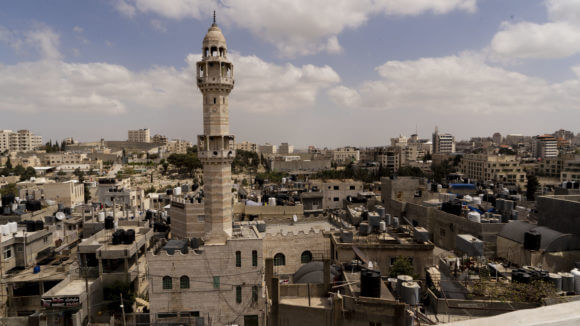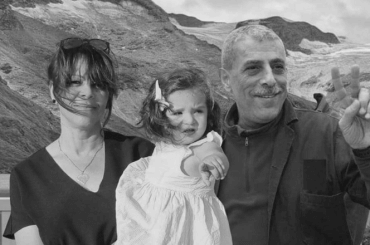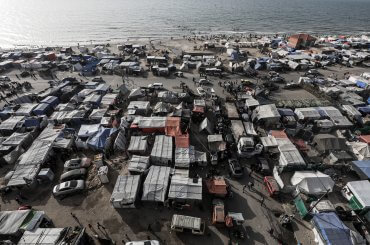A new sense of panic spread across the city of Bethlehem, the epicenter of the coronavirus outbreak in the occupied West Bank, after news broke last week that there were two confirmed cases of the virus in the Dheisheh refugee camp.
The largest of three refugee camps in Bethlehem, Dheisheh is home to at least 15,000 Palestinian refugees, spanning across four generations.
Immediately after the new cases were announced in Dheisheh, Palestinian police and security officers shut down all entrances and exits to the camp, enforcing a mandatory lockdown on all residents.
Like the dozens of other refugee camps in the West Bank, Gaza and East Jerusalem, Dheisheh suffers from overpopulation and lack of general living space, making the camp and its residents even more susceptible than the average citizen to the potentially devastating effects of an outbreak.
“In the camps, there is no such thing as social distancing,” Mohammed Abu Srour, a member of the local council of the Aida refugee camp, which sits just a few kilometers north of Dheisheh, told Mondoweiss.
“Our biggest fear since this whole coronavirus thing began, is ‘what would happen if it reached the camps?’”
‘It would be a disaster’
In the West Bank alone, there are an estimated 775,000 Palestinian refugees, a quarter of whom live in 19 refugee camps across the occupied terrtiory, according to UNRWA, the UN agency repsonsible for providing humanitarian relief to Palesitnian refugees.
The majority of the refugees living in the West Bank are descendants of some 750,000 Palestinains who were made refugees in 1948, and have been stuck in a cycle of poverty ever since.
“In the camps, there is no such thing as social distancing.”
Mohammed Abu Srour, Aida refugee camp
A low-socio-economic level, high rates of unemployment, lack of services from local authorities, and the violent presence of the Israeli occupation have left many Palestinian refugee camps, including the ones in Bethlehem, in desitute conditions.
“One of our biggest issues is overcrowding,” Abu Srour told Mondoweiss, adding that Aida is home to more than 5,000 residents living in an area of around 0.71 square kilometers.
Because many of the residents cannot afford to live beyond the boundaries of the refugee camp, “people have built homes and apartments inside the camp, wherever they have the smallest bit of space.” And when that space runs out, families start cramming together into the same apartment unit.
“We have thousands of people basically living on top of each other,” Abu Srour said, adding that there can be anywhere from 2-3 families living inside one apartment.
Aida Camp is not an anomaly Abu Srour pointed out. “This is the reality of all the refugee camps in Palestine.”
“This virus can travel very quickly in the camps, where everything and everyone depends on social ties between families and neighbors,” he said. “We just can’t afford to have an outbreak in the camps, or else it would be a disaster.”
Prepared for the worst
While the news of the cases in Dheisheh came as a shock for many residents of Bethlehem and its refugee camps, it was something that the camps had been preparing for since the virus first arrived in Bethlehem in early March.
“We were anticipating the potential of the virus spreading in the camps from the very beginning, and knew that we had to be prepared,” Abu Srour said.
In Aida Camp, local youth centers, the local council, and the UNRWA representative in the camp formed an emergency committee to deal with COVID-19, putting the most effort into containment.
“A lot of the centers, along with the local council, began pouring in a lot of their funds into containment efforts and relief for the camp,” he said.
Camp sanitation efforts, the distribution of hygiene packs, and educational campaigns on social media were some of the first initiatives taken by the organizations.
“The local municipality does not really do anything for the camps, so we had to take it upon ourselves to step up for the community,” he continued.
According to Abu Srour, the unemployment rate in Aida skyrocketed to more than 80% after the city was shut down due to COVID-19, putting many of the camp’s families in a dire situation.
“We began putting together food parcels with essentials like bread, flour, oil, rice, and vegetables, and distributing them to the families in the camp,” he said. “A lot of the residents don’t have any savings to fall back on, so we are all they have.”
Another effort, undertaken by a local group of volunteer medics, was to find a way to check up on their chronically ill patients in the camp while maintaining social distancing orders.
Maryam Darwish, 24, is a volunteer with the Community Health Workers program at the Lajee center, one of several youth centers in Aida Camp.
While her and her colleagues typically perform daily checks on over 100 patients in the camp with chronic issues like diabetes and hypertension, when news broke of the coronavirus outbreak in Bethlehem, they quickly switched gears.
“Our patients are some of the people most at-risk of dying from the virus because of their preexisting conditions,” she said. “So we immediately reduced our in-person visits to emergencies only, and provided all of our phone numbers to our patients so they could call us with questions or concerns any time they needed.”
“We also distributed sanitation packs to all of our patients, and began distributing educational pamphlets to inform people about the virus, and most importantly encourage people in the camp to stay at home.”
Like Abu Srour, Darwish expressed the difficulty of enforcing social distancing in a place like Aida, where community ties play a huge role in everyday life.
“Right now, people need to take care as much as they can to protect themselves and their families,” she said. “Because if one person is exposed, then the whole community is at risk.”
UNRWA ‘not doing enough’
The efforts of local organizations and volunteers, even before the COVID-19 outbreak, has been a saving grace for refugee camps like Aida, where the absence of government assistance and dwindling services from agencies like UNRWA has left the already marginalized community in a more vulnerable state.
Despite the initiatives of UNRWA to perform regular sanitiations of the camps, launch educational health campaigns, and in some cases deliver patients’ medications to their door, locals still say it’s not enough.
Throughout the coronavirus crisis in Palestine, the refugee community has been vocal in its criticism of UNRWA and what they say is a “failure” on part of the agency to provide the amount of relief and services the camps need.
“UNRWA is responsible for providing things like healthcare, education, food relief, cash assistance, and work programs for the refugees,” Abu Srour said, “but the only thing we’ve really seen from them during this time is periodic fumigations of the camp.”
Abu Srour acknowledged the fact that UNRWA has taken serious financial blows in recent years, specifically with the withdrawal of funding from the US, it’s biggest donor. “We know they are in a financial crisis, and we appreciate the efforts of their staff in the camp, but they are not covering our most basic needs.”
“People need food, people need cash assistance, people need their healthcare coverage expanded,” he continued. “Instead of letting their funds go to overhead expenses and high salaries for foreign staff, it should go to the refugees that they are supposed to be helping.”
“We have gotten nothing from the PA, nothing from the PLO refugee affairs committee, and nothing from the local municipality,” Abu Srour said. “So if we also can’t get anything from UNRWA, what are we supposed to do?”


